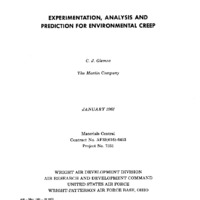-
Title
-
Experimentation, Analysis And Prediction For Environmental Creep
-
Date
-
1961
-
Index Abstract
-
Contrails and DTIC condensed
-
Photo Quality
-
Complete
-
Report Number
-
WADD TR 60-777
-
Corporate Author
-
Martin Company
-
Laboratory
-
Materials Central
-
Extent
-
104
-
Identifier
-
AD0258565
-
AD0258565
-
Access Rights
-
OTS
-
Distribution Classification
-
1
-
Contract
-
AF 33(616)-6453
-
DoD Project
-
7351 - Metallic Materials
-
DoD Task
-
73521
-
DTIC Record Exists
-
Yes
-
Distribution Change Authority Correspondence
-
None
-
Distribution Conflict
-
No
-
Report Availability
-
Full text available
-
Date Issued
-
1961-01
-
Abstract
-
An investigation was made of experimental means for characterizing the creep behavior of bare 7075-T6 aluminum alloy with the aim of developing an experimental approach as well as relations for characterizing a material's response to an arbitrary stress-temperature-time environment following a prior history during which a metallurgical change has occurred.
A technique called Random Balance (Ref. 2), partly modified to a multiple balance design, was employed to select from several million possible environment test combinations a representative group. The general employment of associated techniques for analysis, common to the statistical field, was precluded because of the creep scatter which was attributed to inhomogeneity in the aluminum sheet.
It was found that a loss of strength in the order of 5%, caused by overaging could result in an increase of total creep strain of several hundred percent in subsequent cycles. However, it was also observed that a recovery mechanism, following overaging, could restore a significant degree of resistance to creep.
In every instance, it was found that a transient stage of creep was manifested in each cycle upon reapplication of load. The magnitude of transient creep strain, as well as duration of the transient stage after the initial cycle, diminished as the number of cycles increased for combinations of high stress and high temperature or low stress and low temperature. At test conditions which could be identified with a service environment, the transient creep stage comprised a relatively large fraction of the total creep strain generated during a given cycle.
A qualitative association of creep behavior of the specimens to their origin in aluminum sheet revealed pronounced inhomogeneity which could not be related to static tensile properties. Furthermore, small creep strain differences which specimens exhibited at moderate stresses were magnified during subsequent recycling as the magnitudes of stress and temperature increased; slight overaging further severely aggravated the initial disparities among the specimens.
Excellent reproducibility of an arbitrary test environment was possible when the repeat tests were made with specimens which were obtained from adjoining positions in the sheet. Accordingly, as the distances between specimens in the sheet increased, the differences in creep behavior became greater for identical tests, regardless of nominal identities of static properties.
A method was developed which made it possible to predict the environmental creep behavior for an arbitrary test condition during which overaging at 350°F took place and subsequently, when creep resistance was restored as the result of a recovery mechanism. The technique was based on the strain hardening rule compensated with empirically determined factors to account for creep damage and / or subsequent restoration of creep resistance.
During the examination of compatibility of mathematical forms for the representation of the creep phenomenon, an expression (εc = KtN) provided a good fit in the primary creep region and a reasonably good approximation for part of the secondary stage of creep; an apparently unique correspondence between the values of K and N and the test variables, stress and temperature also was revealed.
-
Subject
-
Aluminum Alloys
-
Creep
-
Sheets
-
Aging (Physiology)
-
Deformation
-
Hardening
-
Load Distribution
-
Stresses
-
Temperature
-
Tensile Properties
-
Test Equipment
-
Test Methods
-
Time
-
Publisher
-
Wright-Patterson Air Force Base, OH : Wright Air Development Division, Air Research and Development Command, United States Air Force
-
AD Number
-
AD 258565
-
Provenance
-
Bombardier/Aero
-
Type
-
report
-
Format
-
1 online resource
-
Creator
-
Giemza, C. J.
 WADDTR60-777.pdf
WADDTR60-777.pdf